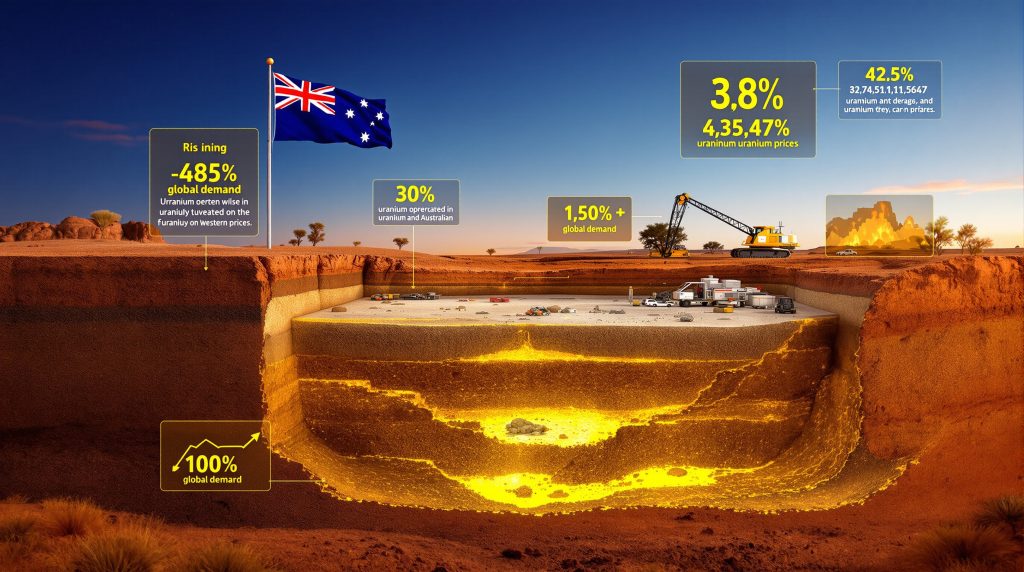What is the Current Status of Uranium Mining in Western Australia?
Western Australia possesses substantial uranium deposits, yet active mining operations remain non-existent due to a state government ban implemented in 2017. This policy restriction has created a unique situation where the state holds valuable resources that remain untapped despite growing global demand for nuclear fuel.
The ban specifically prohibits new uranium mining projects while grandfathering four previously approved developments—Mulga Rock, Kintyre, Wiluna, and Yeelirrie. Despite having regulatory approvals, these projects remain in development limbo, with companies maintaining their assets while awaiting potential policy changes.
Recent political developments suggest the landscape may be shifting. Premier Roger Cook has made increasingly positive statements about reconsidering the uranium mining ban, with a parliamentary inquiry now underway to examine how Western Australia might support its trading partners' decarbonization efforts through resource exports.
The current policy inconsistency is particularly striking—Western Australia recently announced a $12 billion investment in submarine sustainment facilities that will house vessels with 90% enriched uranium, while simultaneously prohibiting uranium mining in Western Australia at 0.7% concentration.
Why is Western Australia's Uranium Potential Significant?
Substantial Resource Base
Western Australia's uranium resources represent a significant portion of Australia's total uranium potential, with deposits containing competitive grades compared to currently operating mines in other states. The state's geology offers favorable conditions for both conventional and in-situ recovery (ISR) mining methods, providing flexibility for potential developers.
The economic implications are substantial—industry experts suggest uranium mining in Western Australia could generate over A$1 billion in annual revenue if operations were permitted to commence. This economic potential has become increasingly relevant as global uranium prices have surged in recent years amid supply constraints and renewed interest in nuclear energy.
Australia possesses more uranium resources than any other country, yet Western Australia's portion remains entirely undeveloped due to policy restrictions rather than economic or technical limitations.
Strategic Importance
The strategic value of Western Australia's uranium extends beyond simple economics. As major trading partners like Japan, South Korea, and potentially India pursue nuclear energy as part of their decarbonization strategies, Western Australia's ability to supply uranium could strengthen diplomatic and trade relationships.
This strategic dimension has become more pronounced as countries seek to diversify their uranium supply chains away from traditional sources like Kazakhstan and Russia, creating opportunities for Western Australia to position itself as a reliable, politically stable supplier.
Industry analysts note that Western Australia could play a crucial role in helping the United States address its US uranium market disruption with high-ESG, Western-leaning uranium supply—potentially becoming a negotiating point in broader trade discussions between Australia and the US.
What Are Western Australia's Major Uranium Projects?
Mulga Rock Project
Located approximately 290 kilometers northeast of Kalgoorlie in the Great Victoria Desert, the Mulga Rock Project represents one of Western Australia's largest undeveloped uranium resources. The project has received state ministerial approval and progressed through various regulatory stages.
Current development activities focus on optimizing mining parameters and environmental management strategies, with a feasibility study scheduled for completion by mid-2025. The deposit contains approximately 71.2 million pounds of uranium oxide (U₃O₈) at an average grade of 570 ppm.
The project's location in a remote area presents logistical challenges but also minimizes potential impacts on populated areas, an important consideration for public acceptance of uranium development.
Yeelirrie Deposit
The Yeelirrie deposit, situated about 70 kilometers southwest of Wiluna, ranks among Australia's largest undeveloped uranium resources. The project received environmental approval in 2017 despite controversy regarding potential impacts on subterranean fauna.
With estimated resources of approximately 128 million pounds of uranium oxide, Yeelirrie represents a significant potential contributor to global uranium supply. The deposit's relatively shallow nature makes it amenable to open-pit mining methods, though development remains contingent on policy changes.
Environmental approvals for this project required extensive baseline studies and monitoring plans, establishing important precedents for how uranium projects can be developed responsibly in Western Australia's unique environments.
Wiluna Project
Located near the historic gold mining town of Wiluna, this project encompasses several uranium deposits including Lake Way and Centipede. The project has secured necessary environmental approvals and completed feasibility studies demonstrating economic viability.
The Wiluna Project's advantage lies in its potential for staged development, allowing for incremental capital investment and production growth. The deposits are amenable to US ISR uranium production methods, which typically have lower environmental impacts than conventional mining.
The project's proximity to existing infrastructure and a community with mining experience provides advantages for potential development, including reduced capital requirements and potential workforce availability.
Kintyre Project
Situated in the remote eastern Pilbara region, the Kintyre deposit was discovered in the 1980s and has undergone extensive evaluation. The project received environmental approval in 2015 but faces challenges related to its remote location and infrastructure requirements.
The deposit contains approximately 55 million pounds of uranium oxide at grades competitive with operating mines globally. Development plans include conventional open-pit mining with processing facilities designed to minimize environmental footprint.
Kintyre's location within the boundaries of a former national park required particularly rigorous environmental assessment processes, establishing important precedents for responsible resource development in environmentally sensitive areas.
What Environmental Considerations Impact Uranium Mining in WA?
Groundwater Protection
Groundwater protection represents one of the most significant environmental considerations for uranium mining in Western Australia. The state's arid environment makes water resources particularly precious, and concerns about potential contamination have featured prominently in debates about uranium development.
Regulatory frameworks require comprehensive groundwater monitoring programs and management plans, with particular attention to preventing acid mine drainage and radionuclide migration. Modern mining techniques incorporate multiple protective barriers and treatment systems to safeguard water resources.
Industry specialists note that in-situ recovery (ISR) methods, which are applicable to some Western Australian deposits, typically have smaller surface footprints and can offer advantages for water management compared to conventional mining, though they require careful aquifer characterization and monitoring.
Radiation Management
Radiation management forms another critical aspect of environmental protection for uranium operations. Western Australia's regulatory framework includes specific provisions for radiation safety, requiring detailed monitoring programs and management strategies.
These requirements cover worker protection, dust suppression, waste management, and transportation protocols. Modern uranium operations implement comprehensive radiation management systems that typically keep exposures well below regulatory limits for both workers and surrounding communities.
"The reality is that Australian uranium mines operate with radiation exposure levels for workers at a fraction of regulatory limits, with sophisticated monitoring systems ensuring transparency and accountability." – Mining industry safety expert
Rehabilitation Requirements
Mine closure and rehabilitation standards for uranium projects exceed those for conventional mining operations, reflecting the long-term nature of radiological considerations. Rehabilitation plans must demonstrate how sites will be returned to stable, non-polluting conditions suitable for agreed post-mining land uses.
Financial assurance mechanisms ensure companies maintain adequate resources for rehabilitation activities regardless of operational outcomes. These requirements add to project costs but provide important environmental safeguards.
Modern rehabilitation techniques focus not only on physical stability and containment of materials but also on establishing sustainable ecosystems that can function without ongoing management—an approach that represents best practice for all types of mine reclamation importance across the mining sector.
How Might Policy Changes Affect Western Australia's Uranium Sector?
Parliamentary Inquiry Process
The current parliamentary inquiry represents a structured approach to policy reconsideration, allowing all stakeholders to present evidence and perspectives. The inquiry specifically examines how Western Australia can support trading partners' decarbonization efforts through resource exports, creating space for uranium to be considered alongside other energy commodities.
Industry submissions to the inquiry have emphasized uranium's role in low-carbon energy systems and Western Australia's potential competitive advantages as a supplier. The inquiry is scheduled to report back to government in September 2025, potentially setting the stage for policy adjustments.
The inquiry's timing appears strategically calculated to allow policy evolution without making uranium a focal point during the next state election in March 2029—demonstrating the political calculations underlying resource policy decisions.
Political Calculations
Political considerations surrounding uranium policy involve balancing economic opportunities against environmental concerns and public sentiment. The current government appears to be taking a measured approach, using the parliamentary inquiry to build consensus rather than making abrupt policy changes.
The timing of potential policy shifts may reflect electoral calculations, with analysts suggesting changes might occur mid-term to avoid making uranium a focal point during election campaigns. This approach allows for policy evolution while managing political risks.
Industry observers note that Western Australia has previously demonstrated capacity for policy evolution in nuclear-related matters, such as the approval and construction of a radioactive waste repository despite initial policy restrictions—suggesting a pathway for uranium policy reconsideration.
Implementation Pathways
If policy changes proceed, implementation would likely involve a phased approach rather than immediate wholesale changes. Initial steps might include allowing the previously approved projects to advance while maintaining rigorous regulatory oversight.
Regulatory frameworks would need updating to ensure appropriate environmental protections while providing operational certainty for developers. This process would draw on experiences from other Australian jurisdictions where uranium mining occurs, particularly South Australia and the Northern Territory.
A key regulatory reform opportunity involves addressing the "nuclear trigger" under section 21A of the Environmental Protection and Biodiversity Conservation (EPBC) Act, which automatically requires federal environmental assessment for uranium projects regardless of their specific characteristics—a requirement not applied to other commodities.
What Economic Benefits Could Uranium Mining Bring to Western Australia?
Direct Employment Opportunities
Uranium mining operations would create significant employment opportunities across various skill levels. Estimates suggest each major project could generate 300-500 direct jobs during construction phases and 200-300 ongoing operational positions.
These employment benefits would be particularly valuable for regional communities, providing diversification beyond traditional agricultural and mining activities. The specialized nature of uranium operations also creates opportunities for skills development and technical training.
The employment profile of uranium operations differs somewhat from other mining sectors, with a higher proportion of technical and professional roles related to environmental management, radiation safety, and regulatory compliance—potentially creating high-value career pathways for Western Australians.
Supply Chain Development
Beyond direct employment, uranium projects would stimulate supply chain development across Western Australia. This includes specialized services for radiation management, environmental monitoring, and technical consulting, as well as conventional mining support services.
The development of these specialized capabilities could position Western Australian companies to export their expertise to uranium operations globally, creating additional economic benefits beyond direct mining activities.
A notable advantage for Western Australian uranium development is the lower capital intensity compared to some other mining sectors—industry experts suggest uranium projects typically require "a couple hundred million" in capital expenditure rather than billions, potentially reducing financing hurdles and increasing the proportion of expenditure captured by local businesses.
Revenue Generation
Government revenue from uranium mining would come through various channels including royalties, payroll taxes, and corporate income taxes. While specific revenue projections depend on production volumes and uranium prices, industry estimates suggest annual government revenue could exceed A$100 million at full production.
These revenue streams could support infrastructure development, community services, and economic diversification initiatives, particularly in regional areas where uranium projects are located.
The timing of these potential benefits aligns with broader economic diversification goals for Western Australia, as the state seeks to develop new industries and revenue streams beyond traditional strengths in iron ore and natural gas.
How Does Western Australia Compare to Other Uranium Mining Jurisdictions?
Regulatory Framework Comparison
Western Australia's regulatory framework for uranium mining, though currently dormant due to the ban, draws on established Australian principles for environmental protection and radiation safety. This framework compares favorably with leading international jurisdictions in terms of comprehensiveness and protective standards.
The state's environmental assessment processes are particularly rigorous, requiring detailed evaluation of potential impacts across multiple environmental domains. This regulatory rigor, while creating approval challenges, ultimately supports sustainable development and social license.
Australia's broader nuclear regulatory system, including the Australian Radiation Protection and Nuclear Safety Agency (ARPANSA) and the Australian Safeguards and Non-Proliferation Office (ASNO), provides additional layers of oversight that exceed requirements in many competing jurisdictions.
Infrastructure Advantages
Western Australia offers significant infrastructure advantages compared to many uranium mining jurisdictions globally. The state's well-developed transportation networks, power systems, and mining support services provide operational efficiencies that enhance project economics.
Port facilities capable of handling uranium exports already exist, eliminating the need for major infrastructure investments that burden projects in less developed regions. These advantages could allow Western Australian projects to achieve competitive production costs despite high labor rates.
The state's experience with complex resource logistics, including remote operations and specialized transportation requirements, provides transferable expertise relevant to uranium logistics and regulatory compliance.
Political Stability
Political stability represents another comparative advantage for Western Australia as a uranium mining jurisdiction. Unlike some major uranium-producing regions that face geopolitical uncertainties or governance challenges, Western Australia offers investors a stable, transparent operating environment.
This stability becomes increasingly valuable as nuclear utilities seek supply diversification and security, potentially allowing Western Australian producers to command premium prices for their production.
Western Australia's established mining culture and experience with international resource markets provides a foundation for uranium sector development that many competing jurisdictions cannot match—creating potential competitive advantages despite the current policy restrictions.
What Does the Future Hold for Uranium Mining in Western Australia?
Short-Term Outlook
The short-term outlook for uranium mining in Western Australia depends heavily on the outcome of the current parliamentary inquiry and subsequent policy decisions. Industry participants are cautiously optimistic about positive developments within the next 12-18 months.
Companies with approved projects continue advancing preparatory activities, positioning themselves to move quickly if policy changes occur. This includes maintaining environmental baseline data, updating technical studies, and engaging with stakeholders.
An important near-term consideration is the global uranium market volatility, with spot prices having strengthened significantly in recent years and contracting prices remaining firm—creating potentially favorable economics for new projects if policy barriers are removed.
Medium-Term Potential
If policy changes proceed, the medium-term outlook could see the first uranium mines entering production within 3-5 years of approval. Initial development would likely focus on the most advanced projects—Mulga Rock and Wiluna—with others following as market conditions warrant.
Production ramp-up would be gradual, reflecting both technical considerations and the need to secure long-term sales contracts with nuclear utilities. Western Australian production could reach 5-10 million pounds annually by the early 2030s.
This timeline represents a critical consideration for global uranium supply planning, as industry experts note that developing new uranium mines typically requires approximately 20 years from discovery to first production—making near-term policy decisions particularly important for addressing potential supply gaps in the early 2030s.
Long-Term Significance
The long-term significance of Western Australia's uranium industry extends beyond direct economic benefits to include strategic positioning in global energy markets. As nuclear energy plays an increasing role in decarbonization efforts, reliable uranium suppliers will gain strategic importance.
Western Australia has the potential to become a significant uranium supplier globally, potentially ranking among the top five producing regions if its resource base is fully developed. This would enhance Australia's role in global energy security while supporting domestic economic objectives.
The sector's development would create opportunities for Western Australia to participate in higher-value segments of the nuclear fuel cycle, potentially including conversion and fuel fabrication activities that could generate additional economic benefits beyond raw material production.
How Might Community Perspectives Influence Uranium Development?
Indigenous Community Engagement
Engagement with Indigenous communities represents a critical aspect of uranium development in Western Australia. Many potential projects are located on traditional lands, requiring comprehensive consultation and agreement-making processes.
Successful developments will need to demonstrate meaningful benefits for Indigenous communities, including employment opportunities, business development, and cultural heritage protection. Early and sustained engagement will be essential for building relationships based on trust and mutual respect.
Companies pursuing uranium development increasingly recognize that Indigenous knowledge and perspectives can provide valuable insights for environmental management and project design—creating opportunities for collaborative approaches that enhance project outcomes while respecting cultural values.
Regional Community Perspectives
Regional communities near potential uranium developments generally demonstrate mixed perspectives, balancing economic opportunity against environmental concerns. Support tends to be stronger in communities with existing mining experience and where economic diversification is valued.
Companies pursuing uranium development recognize the importance of transparent communication and demonstrated commitment to environmental protection in building community support. This includes making technical information accessible and responding substantively to community concerns.
Educational initiatives about modern mining practices and regulatory safeguards play an important role in addressing community concerns—with experiences from South Australia's 40-year history of uranium mining providing relevant examples of successful community engagement and relationship building.
Broader Public Sentiment
Broader public sentiment regarding uranium mining has evolved over time, with increasing recognition of nuclear energy's role in addressing climate change. This evolution creates space for more nuanced discussion about uranium mining's costs and benefits.
Educational initiatives that provide factual information about modern uranium mining practices and regulatory safeguards can help inform public perspectives. Industry participants recognize that maintaining public confidence requires demonstrated performance and transparency.
The increasing focus on climate change mitigation and clean energy transitions provides context for reconsidering uranium's role in Western Australia's resource strategy—particularly as major trading partners pursue nuclear energy as part of their decarbonization plans.
What Lessons Can Be Learned from Existing Australian Uranium Operations?
Operational Experience
Existing uranium operations in South Australia and the Northern Territory provide valuable operational experience relevant to potential Western Australian developments. These operations demonstrate that uranium mining can be conducted safely and responsibly within the Australian regulatory framework.
Specific lessons include effective dust management techniques, radiation protection protocols, and environmental monitoring approaches. These established practices provide a foundation for Western Australian operations to build upon.
The experiences of Honeymoon and Beverly Four Mile, Australia's two operating ISR projects, offer particularly relevant insights for companies considering this mining method in Western Australia—including wellfield design, leaching chemistry, and water management approaches.
Regulatory Effectiveness
The effectiveness of regulatory frameworks in other Australian jurisdictions offers important lessons for Western Australia. These frameworks have generally proven capable of ensuring environmental protection while allowing economically viable operations.
Key elements include clear performance standards, risk-based approaches to compliance monitoring, and transparent reporting requirements. Western Australia can adapt these elements to its specific context while maintaining rigorous environmental protection.
The experience of regulating uranium transportation from existing operations provides relevant precedents for Western Australian logistics planning—demonstrating that uranium oxide concentrate can be transported safely using established protocols and compliance systems.
Stakeholder Engagement Approaches
Successful stakeholder engagement approaches from existing operations highlight the importance of transparency, consistency, and responsiveness. Companies that maintain open communication channels and demonstrate willingness to address concerns build stronger relationships with host communities.
Formal mechanisms such as community reference groups and independent monitoring programs have proven particularly effective in building trust and facilitating constructive dialogue. These approaches will be equally important for Western Australian developments.
The experience of building social license for uranium operations in South Australia over 40 years demonstrates that community acceptance can be achieved through consistent performance, transparent communication, and demonstrated commitment to responsible practices.
FAQs About Uranium Mining in Western Australia
Is uranium mining currently allowed in Western Australia?
No, uranium mining is currently prohibited in Western Australia under a policy implemented in 2017. However, four projects that received approval prior to the ban—Mulga Rock, Yeelirrie, Wiluna, and Kintyre—are technically permitted to proceed, though none have commenced production due to market conditions and policy uncertainty.
What safety measures would be implemented at Western Australian uranium mines?
Western Australian uranium mines would implement comprehensive safety measures including radiation management programs, dust suppression systems, specialized training for workers, and extensive environmental monitoring. These measures would comply with both state regulations and Commonwealth requirements under the Australian Radiation Protection and Nuclear Safety Agency (ARPANSA) guidelines.
How would uranium be transported from Western Australian mines?
Uranium would be transported as uranium oxide concentrate (yellowcake) in sealed drums packed in secure shipping containers. Transportation would follow strict protocols established by Australian Safeguards and Non-Proliferation Office (ASNO) and international regulations. Routes would be approved by regulatory authorities with appropriate security measures in place.
What economic benefits might uranium mining bring to regional communities?
Regional communities could benefit from uranium mining through direct employment opportunities, business development in the supply chain, infrastructure improvements, and community development programs. Specific benefits would depend on project scale and location, but typically include training programs, local procurement initiatives, and community investment funds.
How does uranium mining compare environmentally to other mining activities?
Uranium mining faces similar environmental challenges to other mining activities but with additional considerations related to radiation management. Modern uranium operations implement specialized environmental management systems addressing these unique aspects. Water management, land rehabilitation, and biodiversity protection approaches are comparable to best practices in other mining sectors but with enhanced monitoring requirements.
Important Disclaimer: This article discusses potential future developments in Western Australia's uranium mining sector that remain subject to policy changes and regulatory approvals. Economic projections and timelines represent industry estimates rather than confirmed outcomes. Readers should consult official government sources and company announcements for the most current information regarding project status and regulatory developments.
Want to Catch the Next Major Mineral Discovery?
Stay ahead of the market with real-time alerts on significant ASX mineral discoveries powered by Discovery Alert's proprietary Discovery IQ model. Explore how historic discoveries have generated substantial returns by visiting our dedicated discoveries page and begin your 30-day free trial today.




